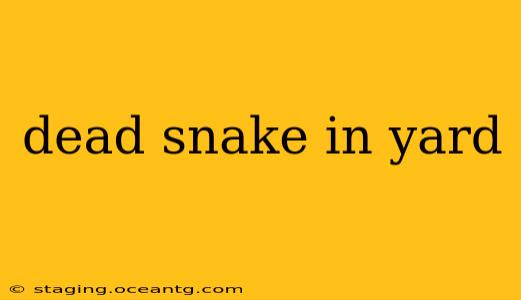Finding a dead snake in your yard can be unsettling, but it's a relatively common occurrence. While the sight might be alarming, it's important to react calmly and responsibly. This guide will walk you through the appropriate steps to take, address common concerns, and provide valuable information about snake safety.
What Kind of Snake is it?
Identifying the snake species can help determine the potential risks and the best removal method. While it's safest to avoid handling the snake, taking a picture from a safe distance can help with identification. You can then use online resources or contact your local wildlife agency or animal control for assistance. Knowing the species can also provide insights into why it died.
Is it Dangerous? (Even Dead?)
Even a dead snake can pose a slight risk. Certain species, like rattlesnakes and copperheads, retain venom in their tissues even after death. Their fangs can still inflict a bite if handled carelessly. Therefore, never attempt to handle a dead snake with your bare hands.
How Should I Dispose of a Dead Snake?
The best method for disposing of a dead snake depends on local regulations and the size of the snake. Smaller snakes can often be placed in a sealed plastic bag and disposed of in your regular trash. Larger snakes may require a different approach. Contact your local waste management service for guidance on handling larger carcasses. You could also contact animal control; they may have specific procedures for handling deceased snakes.
Why is there a Dead Snake in My Yard?
There are several reasons why you might find a dead snake in your yard. Natural causes like illness, old age, or injuries sustained during fights are common. Predators, such as birds of prey or other snakes, can also kill snakes. Exposure to pesticides or other toxins is another possibility. If you've recently used pesticides, it's important to keep pets and children away from the area.
What Attracts Snakes to My Yard?
Understanding what attracts snakes to your property can help prevent future encounters. Snakes are often drawn to areas with ample food sources, such as rodents, insects, and other small animals. Dense vegetation, woodpiles, and rock piles provide excellent hiding places. Removing potential food sources and maintaining a clean, well-maintained yard can help deter snakes.
Should I Be Worried About More Snakes?
Finding one dead snake doesn't necessarily mean more are on their way. However, it's a good indication that snakes are present in the area. Continue to be cautious, keep your yard clean, and take steps to eliminate potential hiding places and food sources.
What if I have Pets or Children?
If you have pets or children, take extra precautions after finding a dead snake. Ensure the area where the snake was found is thoroughly cleaned. Keep pets on a leash and supervise children closely while playing outdoors. Teaching children about snake safety is also crucial. Never let them approach or touch a snake, dead or alive.
My Dog or Cat Killed a Snake - Is My Pet Safe?
If your pet killed a snake, monitor them closely for any unusual symptoms such as lethargy, swelling, vomiting, or difficulty breathing. If you suspect a venomous snake bite, contact your veterinarian immediately. Some species, even if killed by your pet, are still dangerous if ingested.
What if I'm Afraid of Snakes?
It's perfectly normal to be afraid of snakes. If the presence of a dead snake is causing you significant distress, contact your local animal control or wildlife removal service for assistance. They can safely remove the snake and provide advice on snake prevention.
This comprehensive guide provides a balanced and informative overview of handling the situation of finding a dead snake in your yard. Remember safety is paramount – always prioritize your own safety and the safety of your family and pets when dealing with snakes.
